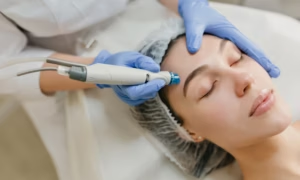As we age, our skin loses elasticity, leading to sagging and wrinkles. There are many cosmetic procedures available to combat these signs of aging, including radiofrequency skin tightening. In this article, we’ll delve into the science behind radiofrequency skin tightening, how it works, and its benefits.
What is Radiofrequency Skin Tightening?
Radiofrequency skin tightening is a non-invasive cosmetic procedure that uses radiofrequency energy to heat the deeper layers of the skin, causing collagen fibers to contract and tighten. This results in firmer, smoother skin, reducing the appearance of wrinkles and sagging.
How Does Radiofrequency Skin Tightening Work?
Radiofrequency energy is a type of electromagnetic radiation that generates heat when it comes into contact with tissue. During a radiofrequency skin tightening treatment, a device is used to deliver radiofrequency energy to the skin, which heats the deeper layers of tissue. The heat causes collagen fibers to contract, stimulating the production of new collagen, which further tightens the skin.
Radiofrequency skin tightening is a relatively painless procedure, with most patients experiencing only a slight warming sensation during treatment. There is little to no downtime, and patients can return to their normal activities immediately after treatment.
What are the Benefits of Radiofrequency Skin Tightening?
There are many benefits to radiofrequency skin tightening, including:
- Non-invasive: Radiofrequency skin tightening is a non-invasive procedure, meaning there are no incisions or needles required. This reduces the risk of scarring and infection and eliminates the need for downtime.
- Effective: Radiofrequency skin tightening has been shown to be effective in reducing the appearance of wrinkles and sagging skin. The results are natural-looking and long-lasting.
- Safe: Radiofrequency skin tightening is a safe procedure, with few side effects. Most patients experience only mild redness or swelling, which typically resolves within a few hours.
- Versatile: Radiofrequency skin tightening can be used on many areas of the body, including the face, neck, arms, abdomen, and thighs. This makes it a versatile option for patients looking to tighten and firm multiple areas of the body.
Who is a Good Candidate for Radiofrequency Skin Tightening?
Radiofrequency skin tightening is suitable for most patients, but it is especially effective for those who have mild to moderate skin laxity. It is not recommended for patients with severe sagging or those with significant sun damage, as these issues may require more invasive procedures.
Before undergoing radiofrequency skin tightening, patients should consult with a licensed dermatologist or cosmetic surgeon to determine if the procedure is right for them.
Are There Any Risks or Side Effects of Radiofrequency Skin Tightening?
Radiofrequency skin tightening is a safe procedure, with few side effects. However, some patients may experience mild redness, swelling, or discomfort following treatment. These side effects typically resolve within a few hours.
In rare cases, patients may experience more serious side effects, such as burns or scarring. To minimize the risk of complications, patients should choose a licensed and experienced cosmetic surgeon or dermatologist to perform the procedure.
How Many Treatments Are Needed for Radiofrequency Skin Tightening?
The number of radiofrequency skin tightening treatments needed depends on the individual patient and the area being treated. Most patients require multiple treatments, spaced several weeks apart, to achieve optimal results.
Is Radiofrequency Skin Tightening Permanent?
While radiofrequency skin tightening is effective in reducing the appearance of wrinkles and sagging skin, the results are not permanent. Over time, the natural aging process will continue, and the skin will begin to lose elasticity once again.
However, patients can maintain their results by undergoing periodic maintenance treatments. These treatments can help to prolong the effects of radiofrequency skin tightening, keeping the skin looking firm and youthful for longer.
Conclusion
Radiofrequency skin tightening is versatile and can be used on many areas of the body, including the face, neck, arms, abdomen, and thighs. It is most effective for patients with mild to moderate skin laxity, but it may not be suitable for those with severe sagging or significant sun damage.
While the results of radiofrequency skin tightening are not permanent, patients can maintain their results by undergoing periodic maintenance treatments. This can help to prolong the effects of the procedure, keeping the skin looking firm and youthful for longer.
In conclusion, radiofrequency skin tightening is a safe and effective way to reduce the signs of aging and achieve smoother, firmer skin. If you’re interested in this procedure, consult with a licensed and experienced cosmetic surgeon or dermatologist to determine if it is right for you.



































